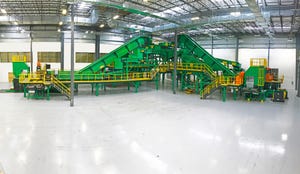Landfill operators have traditionally dealt with leachate by discharging it to publicly owned treatment works (POTWs) as a simple and inexpensive disposal method. But as POTWs face tighter regulations that impose more stringent discharge limits, the landscape is transforming.
Some of these treatment plants have stopped accepting landfill leachate altogether due to river consequences, says Bryan Staley, president and CEO of the Environmental Research and Education Foundation.
Meanwhile, costs to manage these fast-accumulating liquid contaminants are climbing, consuming up to 40 percent of landfill operating expenses, show industry stats.
So throughout much of the U.S., solid waste disposal companies are re-examining options to move out the massive volumes of leachate they continue generating.
Working with POTWs is still most landfill owners’ first choice when feasible. But before they go this route, they should understand treatment plants’ issues—issues that can drive future changes and expectations that will impact landfills’ disposal operations.
Landfill leachate has been especially problematic for POTW’s that use UV light as a method for disinfection.
“Discharging landfill leachate to wastewater treatment plants brings in UV QS. These are chemicals that absorb UV light in water, decreasing its strength and reducing efficiency of UV disinfection,” says Yang Deng, an associate professor at Montclair State University in New Jersey. Deng is working on ways to reduce UV QS before leachate is discharged.
Pretreating leachate to lessen POTW’s load?
“In the best case scenario landfill operators [who dispose leachate at POTWs] just have to discharge into sewers, though there are certain discharge limits with regard to organic and inorganic constituents. So there will be times a landfill will have to pretreat leachate to comply with POTW limits,” says Kevin Torrens, vice president at Brown and Caldwell, a consulting firm based in Walnut Creek, Calif. An additional driver to pretreat he says is a reduction in surcharge costs.
POTWs have other drawbacks that challenge landfill operators in controlling their destiny. These treatment plants can raise their rates quickly. And they can impose new leachate limits, especially as their own situations change, whether those changes be new government regulations or a transition to new technology. And some of these changes are edging out, or can edge out, landfills.
While most POTWs use chlorine to disinfect, some are moving toward UV disinfection as chlorine is dangerous to handle and can create byproducts that are toxic in water. The potential for leachate to interfere with the alternative method may push POTW’s over their limit for their disinfection requirements.
Further, in some regions EPA is tightening nutrient limitations with nitrogen being particularly problematic as landfill leachate can have 30 to 50 times the nitrogen concentration than domestic sewage.
Pretreating leachate onsite may solve some problems
Among the main methods, done at landfills, to cut contamination are evaporation and biological treatments. With evaporation, operating and maintaining the equipment can be labor intensive, and the process consumes a lot of energy to boil the water. Though landfills that generate sufficient landfill gas can use it as an alternative energy resource. Recovering heat off of flares or engines is another option.
Biological treatments are similar to POTW’s approaches.
“We put leachate in a tank containing bacteria that consumes organic material and nitrogen, and it purifies the water to a point. Then we separate the liquid and reuse the bacteria. A drawback is that it may have to meet lower limits than biological treatments can achieve on their own. This calls for additional processes to remove contaminants,” says Torrens, adding biological techniques require a costly aeration process, where oxygen is transferred to the tank to allow the bacteria to metabolize contaminants.
Landfills working with a POTW or considering working with one should key in on specific aspects of these plants’ operations, says Torrens.
“See if they are planning to go to UV treatment if they haven’t yet. Understand the regulations in the state where you do business as well as pending regulations. Will the [treatment plant] be hit with tighter regulations, perhaps regarding nitrogen levels in the future? Is the POTW nearing capacity?” says Torrens.
As crucial he says, is establishing a relationship as well as having ongoing conversations about plants’ operations and concerns that play into their decision making.
About the Author
You May Also Like




